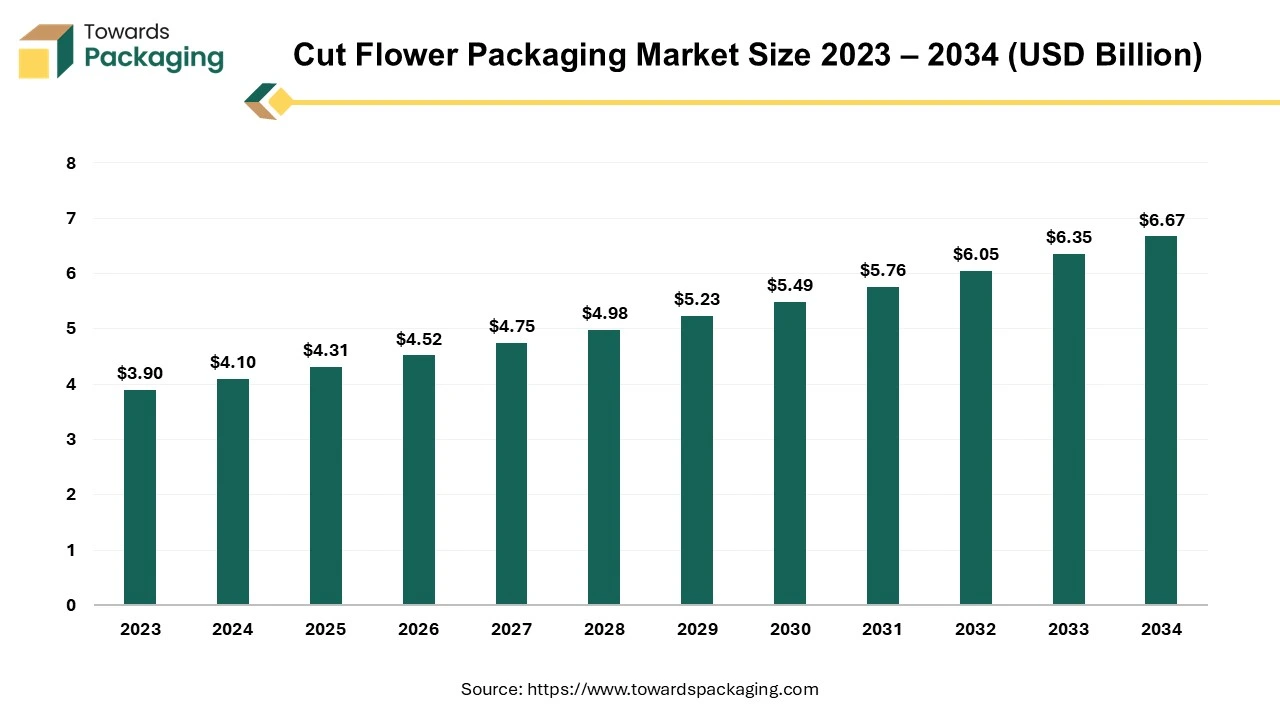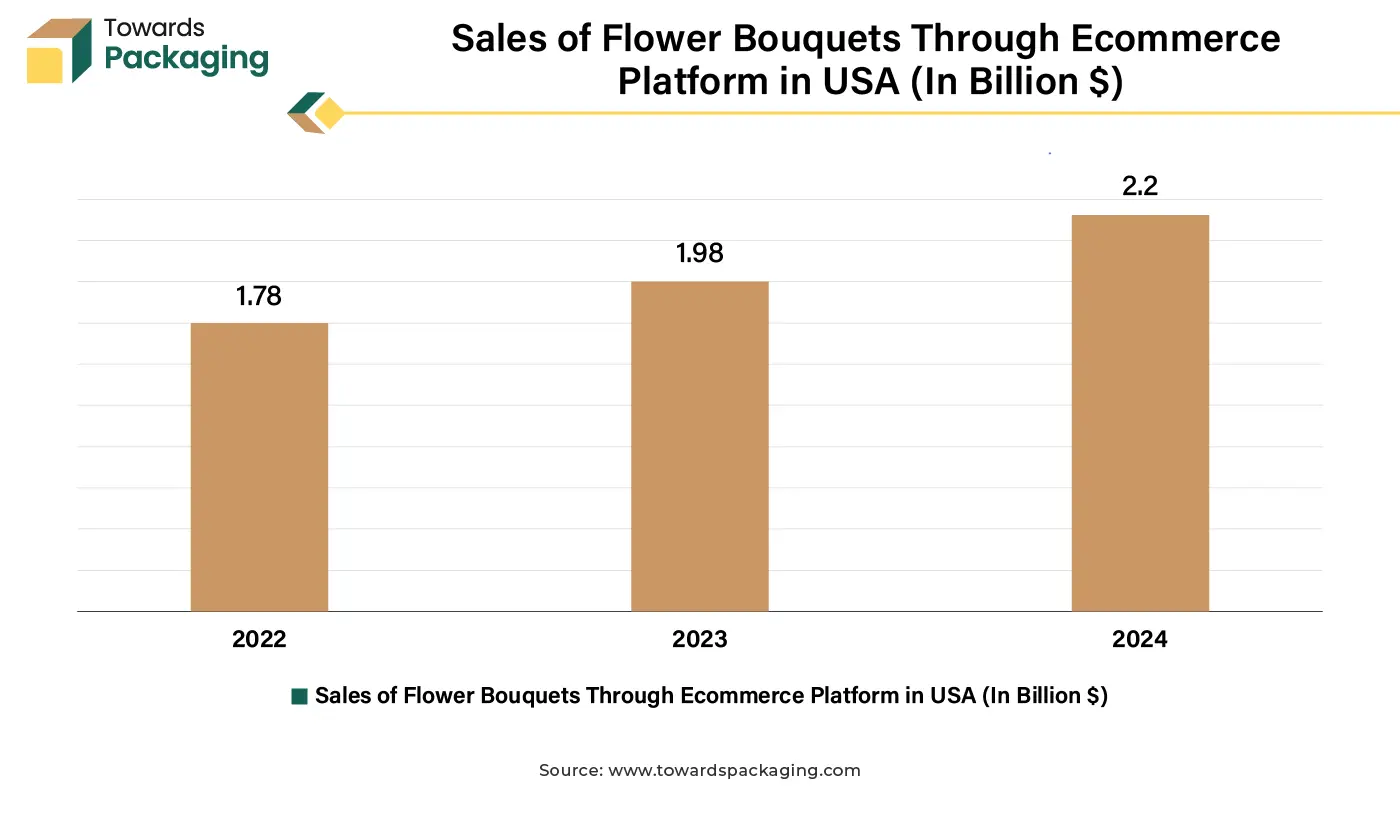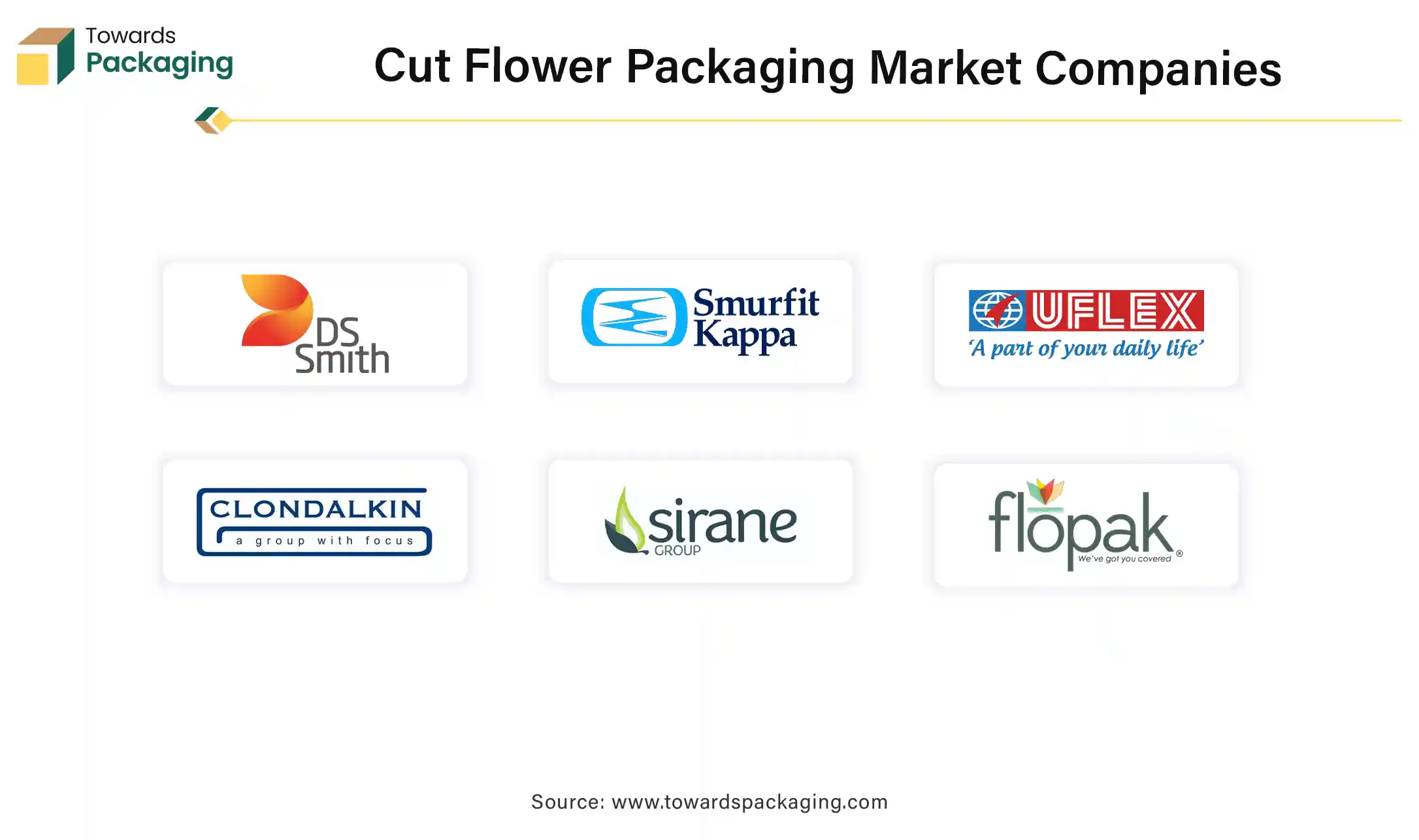April 2025
The global cut flower packaging market size was valued at USD 4.10 billion in 2024 and is expected to enhance around USD 6.67 billion by 2034, growing at a CAGR of 5% from 2025 to 2034.

Unlock Infinite Advantages: Subscribe to Annual Membership
Cut flower packaging refers to the materials and techniques used to protect, preserve, and present fresh-cut flowers during storage, transportation, and retail display. It ensures that flowers remain fresh, hydrated, and visually appealing while minimizing damage from handling, temperature changes, and moisture loss. Proper packaging prevents wilting and dehydration by maintaining optimal humidity levels.
Materials like hydration wraps and floral foams help retain moisture. Some flowers are temperature-sensitive and require cool storage (e.g., roses, tulips). Packaging solutions like insulated wraps or refrigerated boxes help maintain quality. Flowers are delicate and can be easily bruised or crushed during transport. Packaging materials cushion flowers and keep them secure in transit.
Cut flower packaging is essential for preserving freshness, protecting flowers, enhancing aesthetics, and supporting sustainable practices. From flower sleeves and hydration wraps to luxury boxes and eco-friendly solutions, the right packaging choice depends on flower type, transport needs, and customer preferences.
Due to rising environment awareness there’s a notable shift towards using biodegradable and recyclable materials, such as paper, paperboard, and plant-based films, to reduce environmental impact. Eco-conscious consumers are driving the demand for sustainable packaging options, prompting manufacturers to innovate in this space. Manufacturers are partnering with florists, supermarkets, and retail stores to expand their market reach and offer tailored packaging solutions.
Companies are developing packaging that extends the shelf life of cut flowers. For instance, Uflex Ltd.'s 'FlexFresh' solution keeps flowers fresh for up to 15 days without water. There's a growing trend towards offering luxury boxes and customized packaging designs to enhance aesthetic appeal and cater to premium market segments.
The rise of e-commerce has led to an increase in online sales of cut flowers, encouraging packaging manufacturers to develop solutions that ensure product integrity during transit. Manufacturers are partnering with florists, supermarkets, and retail stores to expand their market reach and offer tailored packaging solutions.
Artificial Intelligence (AI) is transforming the cut flower packaging industry by enhancing efficiency, sustainability, and customization while reducing waste and optimizing supply chains. AI-powered freshness sensors can monitor temperature, humidity, and ethylene gas levels inside packaging to ensure flowers remain fresh. IoT-connected smart tags help track real-time conditions during transport and storage, alerting suppliers if adjustments are needed. AI analyzes consumer preferences and environmental impact to develop biodegradable, recyclable, and compostable packaging materials. AI-powered material science helps optimize packaging designs, reducing waste while maintaining durability.
AI-driven predictive analytics optimize inventory management, reducing overstocking or shortages. AI helps forecast demand based on seasonality, weather, and consumer trends. AI-powered route optimization ensures faster delivery times, keeping flowers fresher. For instance, AI logistics software minimizes transit times and optimizes cold-chain packaging solutions. AI allows florists and e-commerce platforms to offer personalized flower arrangements and packaging designs. AI-driven chatbots and recommendation engines suggest flower choices based on occasions, past purchases, and user preferences.
AI can generate custom packaging designs based on customer preferences for luxury bouquets. AI-guided robotic arms automate flower cutting, sorting, and packing, increasing speed and efficiency. AI-driven automation in flower packaging plants reduces manual work while improving consistency. AI is revolutionizing cut flower packaging by making it more efficient, sustainable, and customer-focused. From smart packaging sensors and robotic automation to AI-driven supply chain optimization and personalized designs, AI helps reduce waste, extend shelf life, and improve delivery efficiency.
Expansion of Sales of Flower Bouquet through E-commerce Platform
Online flower delivery services (e.g., 1-800-Flowers, FTD, Bloom & Wild) require durable and aesthetically appealing packaging. Packaging solutions must ensure freshness and prevent damage during transit. Consumers are increasingly buying flowers online, requiring packaging that protects blooms during transit. E-commerce shipping requires stronger, well-ventilated, and moisture-retaining packaging to maintain flower freshness. Online florists use unique, aesthetically pleasing packaging to enhance customer experience and brand identity.
Many e-commerce platforms prioritize sustainable packaging to appeal to environmentally conscious buyers. The rise of flower subscription services fuels demand for specialized, reliable packaging solutions. Rising online flower delivery services (e.g., subscription boxes, e-commerce florists) require durable, temperature-controlled, and visually appealing packaging. Customizable and branded unboxing experiences are becoming a key differentiator.
Online flower shops allow customers to order anytime, anywhere, unlike physical florists with limited hours. Same-day and next-day delivery services make it easier for last-minute purchases. Florists can sell beyond their local area, reaching nationwide and even international customers. Online platforms partner with local florists for fulfilment, enabling wide delivery coverage. E-commerce platforms offer flower subscription services, where customers receive regular deliveries of fresh flowers. This model ensures repeat business and steady revenue for online florists. Online retailers often offer lower prices and promotional discounts, making them attractive compared to traditional florists. Subscription discounts and bundled offers (e.g., flowers + chocolates) increase sales.

61% of British customers kept their spending levels from the previous year, demonstrating the extraordinary stability of Valentine's Day expenditures. Despite persistent economic difficulties, only 16% of respondents intend to cut back on their Valentine's Day spending, while 13% want to increase their expenditure.
Stringent Environmental Regulations & Seasonal Demand Fluctuations
The key players operating in the market are facing issue due to seasonal demand fluctuation and stringent environmental regulations which may restrict the growth of the cut flower packaging market. Governments worldwide are imposing bans on plastic packaging and encouraging sustainable alternatives, which require innovation and investment in research and development. The cut flower market is highly seasonal, with peaks during Valentine's Day, Mother's Day, and weddings, leading to inconsistent demand for packaging solutions. Many consumers prefer buying fresh flowers directly from farmers' markets or florists without elaborate packaging, reducing demand for packaged solutions.
Growth in Premium & Luxury Floral Gifting
Demand for high-end packaging for luxury floral brands and event gifting (e.g., rigid boxes, velvet finishes, personalized packaging). Seasonal and festival-driven packaging (e.g., Valentine’s Day, Mother’s Day, weddings).
The sleeves segment held a dominant presence in the cut flower packaging market in 2024. Flower sleeves are generally made of plastic or paper, making them affordable compared to rigid packaging options like boxes. They require less material, reducing production and shipping costs. Pre-formed sleeves allow for quick and efficient flower arrangement and wrapping. They are easy to handle, which is essential for high-volume retail sales (e.g., supermarkets, florists). Sleeves offer adequate protection from physical damage while allowing air circulation, which helps maintain flower freshness. Some sleeves have water-resistant coatings to prevent wilting. Flower sleeves can be custom-printed with logos, messages, and designs, making them an excellent branding tool. Different sizes and shapes cater to various flower arrangements.
The plastic material type segment led the global cut flower packaging market. Plastic materials (e.g., polypropylene (PP), polyethylene (PE), PET) are cheaper than alternatives like paper or fabric. Mass production of plastic sleeves and wraps reduces costs for flower growers and retailers. Clear plastic allows full visibility of the flowers, making them more attractive to consumers. Transparency & aesthetic appeal enhances impulse buying in supermarkets, florists, and online sales.
Plastic prevents moisture loss, keeping flowers fresh for a longer time. Plastic material protects against dust, contaminants, and mechanical damage during transportation. Plastic sleeves and wraps are tear-resistant, ensuring flowers remain protected throughout the supply chain. Extends the shelf life of flowers by reducing exposure to air and bacteria.
The florist channel segment accounted for a considerable share of the cut flower packaging market in 2024. Florists offer tailor-made bouquets, allowing customers to choose specific flowers, colors, and arrangements. Special occasions like weddings, anniversaries, and funerals often require personalized floral designs. Florists have expertise in floral design, creating visually appealing and long-lasting bouquets. They use high-quality, fresh-cut flowers, ensuring better durability than mass-produced bouquets from supermarkets.
Florists are the go-to choice for events like weddings, birthdays, graduations, and corporate functions. Customers trust florists for elegant arrangements that match themes and aesthetics. Florist bouquets often have a premium feel, with high-end wrapping, exotic flowers, and intricate designs. Many customers prefer florists for luxury gifting, as opposed to supermarket flowers that may look generic.
The bunch/ bouquet segment dominated the cut flower packaging market globally. Bouquets are more visually striking than a single flower, making them a preferred choice for gifting and decoration. A mix of colors, textures, and flower types creates a richer, more luxurious look. Bouquets are seen as a complete gift, while single flowers may appear too simple or informal. They are popular for birthdays, anniversaries, Valentine’s Day, weddings, and corporate events.
Buyers feel they are getting more for their money with a bouquet rather than just a single stem. Bouquets often include fillers (e.g., baby’s breath, eucalyptus) that enhance volume without a significant cost increase. Different flowers in a bouquet can convey multiple emotions or messages, making them more meaningful. Bouquets are pre-arranged, making them easy to display at home or in events. No need for buyers to arrange flowers themselves, unlike single-cut flowers.
Europe region dominated the global cut flower packaging market in 2024. The Netherlands is the global hub for floriculture, with Royal FloraHolland being the largest flower auction in the world. Countries like Germany, the UK, France, and Italy also have high flower consumption rates, supporting demand for packaging. The region has a well-established retail network, including supermarkets, florists, and e-commerce platforms. The EU has strict environmental policies, encouraging the use of biodegradable, compostable, and recyclable packaging. Consumers prefer paper-based, biodegradable plastics, and reusable packaging over traditional plastic wraps.
Europe has well-developed transport and cold chain systems, allowing flowers to stay fresh for longer. Efficient packaging solutions, such as modified atmosphere packaging (MAP), help maintain flower freshness. Europe is at the forefront of adopting eco-friendly packaging solutions, driven by stringent environmental regulations and consumer preferences. The emphasis is on biodegradable, recyclable, and compostable materials to reduce environmental impact. Decowraps is key player in Europe with over 20 years of experience, Decowraps is a leading supplier of distinctive floral and potted packaging options, known for exceptional design and innovation.
Asia Pacific region is anticipated to grow at the fastest rate in the cut flower packaging market during the forecast period. In China flowers are essential in festivals like the Spring Festival and Qixi Festival (Chinese Valentine’s Day). India has high demand for flowers in weddings, temples, and religious ceremonies (e.g., marigolds, jasmine, and roses). Japan has traditional practices like Ikebana (flower arranging) and Hanami (cherry blossom viewing) contribute to a steady demand for flowers.
Rapid digitalization and the rise of online flower shops (e.g., Ferns N Petals in India, FlowerAdvisor in Southeast Asia) are driving market expansion. Contactless delivery services surged after the pandemic, making online flower shopping more popular. Countries like China, India, Thailand, and Malaysia are investing in floriculture, increasing flower production for both domestic and export markets. China and India are becoming major exporters of roses, lilies, and orchids to Europe and the Middle East. Selecta Cut Flowers SAU is a prominent player in the Asia Pacific cut flowers market. Dümmen Orange Holding BV is a leading company in the Asia Pacific cut flowers market.

Micha Danziger Co-CEO of Danziger (plant nursery), stated that the company signed agreement of cut flower distribution in Europe with Kolster BV, plant nursery based in Netherlands focusing on expanding the sales and marketing of its cut-flower variety line-up. In the cut-flower sector, Kolster BV is well-established in Holland, the UK, Germany, Switzerland, and a number of other European nations. With the exception of Portugal, Spain, and Italy, Kolster BV will be Danziger's sole and official distributor across Europe. Along with concentrating on the top Gypsophila, Solidago, and Limonium cultivars, the new collaboration will also introduce Danziger's most recent creations, including Euphorbia Forix M Bliss, Caryopteris Pagoda, and Scabiosa Scoop, to the European market.
By Product Type
By Material Type
By Sales Channel
By Flower Type
By Region
April 2025
April 2025
April 2025
April 2025